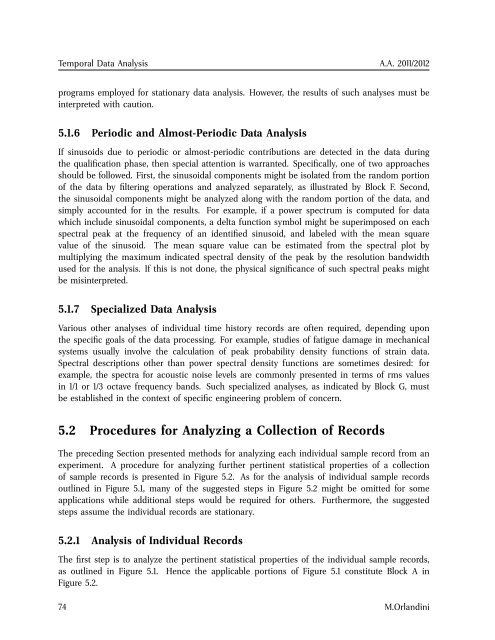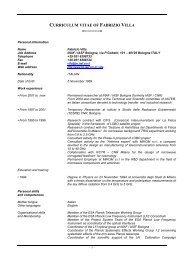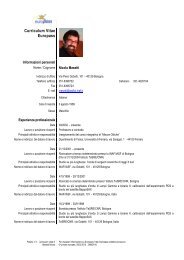booklet format - inaf iasf bologna
booklet format - inaf iasf bologna
booklet format - inaf iasf bologna
Create successful ePaper yourself
Turn your PDF publications into a flip-book with our unique Google optimized e-Paper software.
Temporal Data Analysis A.A. 2011/2012<br />
programs employed for stationary data analysis. However, the results of such analyses must be<br />
interpreted with caution.<br />
5.1.6 Periodic and Almost-Periodic Data Analysis<br />
If sinusoids due to periodic or almost-periodic contributions are detected in the data during<br />
the qualification phase, then special attention is warranted. Specifically, one of two approaches<br />
should be followed. First, the sinusoidal components might be isolated from the random portion<br />
of the data by filtering operations and analyzed separately, as illustrated by Block F. Second,<br />
the sinusoidal components might be analyzed along with the random portion of the data, and<br />
simply accounted for in the results. For example, if a power spectrum is computed for data<br />
which include sinusoidal components, a delta function symbol might be superimposed on each<br />
spectral peak at the frequency of an identified sinusoid, and labeled with the mean square<br />
value of the sinusoid. The mean square value can be estimated from the spectral plot by<br />
multiplying the maximum indicated spectral density of the peak by the resolution bandwidth<br />
used for the analysis. If this is not done, the physical significance of such spectral peaks might<br />
be misinterpreted.<br />
5.1.7 Specialized Data Analysis<br />
Various other analyses of individual time history records are often required, depending upon<br />
the specific goals of the data processing. For example, studies of fatigue damage in mechanical<br />
systems usually involve the calculation of peak probability density functions of strain data.<br />
Spectral descriptions other than power spectral density functions are sometimes desired: for<br />
example, the spectra for acoustic noise levels are commonly presented in terms of rms values<br />
in 1/1 or 1/3 octave frequency bands. Such specialized analyses, as indicated by Block G, must<br />
be established in the context of specific engineering problem of concern.<br />
5.2 Procedures for Analyzing a Collection of Records<br />
The preceding Section presented methods for analyzing each individual sample record from an<br />
experiment. A procedure for analyzing further pertinent statistical properties of a collection<br />
of sample records is presented in Figure 5.2. As for the analysis of individual sample records<br />
outlined in Figure 5.1, many of the suggested steps in Figure 5.2 might be omitted for some<br />
applications while additional steps would be required for others. Furthermore, the suggested<br />
steps assume the individual records are stationary.<br />
5.2.1 Analysis of Individual Records<br />
The first step is to analyze the pertinent statistical properties of the individual sample records,<br />
as outlined in Figure 5.1. Hence the applicable portions of Figure 5.1 constitute Block A in<br />
Figure 5.2.<br />
74 M.Orlandini

















